
High Plains Gardening
The gardening website of the Texas High Plains Region
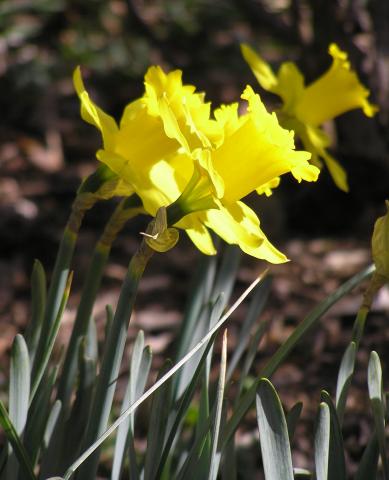
Narcissus, flow’r of inspiring splendor
Trumpet forth Spring’s promised sonnet, tender
Dianne Capell, Excerpt from A Spring Sonnet, 2020
In rural northeastern Oklahoma lies an old cemetery dating back to the days when Oklahoma was known as Indian Territory. On an early springtime day around mid-March, there among the gravestones, you would find clumps of small, yellow trumpet daffodils. Driving in the near vicinity, patches of daffodils line fences and gather around abandoned farmhouses. These daffodils have been identified as Narcissus pseudonarcissus, known as the Lenten Lily in England, dating back centuries.
Research by Russell Studebaker of Tulsa and Old House Gardens identified these and other daffodils and spring bulbs growing around the sites where Cherokee Indians lived. At the site of Chief John Ross, one could find clumps of Narcissus jonquills and N. pseudonarcissus, double daffodils, N. x incomparabilis ‘Butter and Eggs’ (heirloom from 1777), ’Van Sion,’ (1620) and single ‘Campernelle’ (from 1601) and more jonquils along the way. Where these daffodils brought there by the Cherokee people when they were moved there in the 1800’s? It is speculated that was the case. Of more interest, is the fact that these daffodils survived decade after decade with no care from anyone. (Old House Gardens.) 
This is the first of three Garden Notes on the Daffodil. This first article explores to a certain extent the "why" of the daffodil's popularity throughout history. The second Garden Notes in the Daffodil series describes the "what" -- about the governing bodies, classification system and coding -- the system that keeps track of the thousands of daffodil cultivars, Daffodil Organization. And the third in the Daffodil series advises on the "how" of Growing Daffodils in the Texas Panhandle, offering some tips on ordering, planting and growing daffodils in your own garden. (Photo at right from a neighbor's front garden, yellow trumpet and white large-cupped daffodils.)
After admiring, studying and growing tulips for a decade, I would have said the tulip was the most popular spring flower. I would have been wrong, very wrong.
The daffodil is the world’s most popular spring flower, according to the National Gardening Association and others around the world. Daffodils will come back spring after spring with the least of care. But more than that, daffodils herald the end of a long cold, dark winter, it’s bright yellow beaming through the leaves like the sun. It is overcast today with a chill, stiff wind, and I can attest there is nothing like a daffodil in bloom to lift one’s spirit. A vase of daffodils that includes six to ten of different daffodil cultivars, or even a single stem, is the most marvelous vase of flowers one can grow in early springtime! Large and small-cupped, jonquils, doubles and split coronas in differing color patterns pair well together.
The popularity of daffodils is so great, it has achieved the status of a cult flower – flowers that inspire relentless obsession. Clubs, societies, shows and even international organizations adore and promote their use. Individuals devote their sole gardening lives to collections of as many daffodils as they have space, and spend years in the pursuit of breeding new cultivars. People bedeviled with daffodils are said to have “yellow fever.” There are many individual stories about not just the breeders and growers, but the cultivars themselves that inure people to the lovely daffodil. And thank goodness they do!
Like most wildflowers, single daffodils are rather humble in appearance when found in nature, although look glorious when massed and blooming in tandem in spring. But are they daffodils, Narcissus, Lenten lilies, jonquils, johnny-quils, buttercups, daffys, or daffy-down-lilies? The word daffodil is the English word for the genus Narcissus. It’s perfectly correct to call them daffodils, or Narcissus, which ever one prefers. In the American South, daffodils are referred to as jonquils. Jonquils themselves are but one division of Narcissus, Narcissus jonquilla, that includes cultivars of this species.
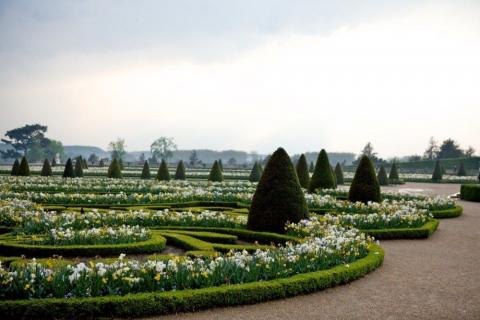
Daffodils have been enjoyed by humans for millenniums and is the subject of myths. The first daffodil mentioned in literature was in the 11th century B.C. by the Greek poet Homer, referring to their native daffodil, Narcissus tazetta, in the Hymn to Demeter: “The Narcissus wondrously glittering, a noble sight for all, whether immortal gods or mortal men; from whose root a hundred heads springeth forth and at the fragrant odour thereof all the broad heaven above and all the earth laughed.” When I think of people living in such distant past, I seldom think of them passionate about flowers such as many of have been in the past few centuries. Native in that part of the Mediterranean area, the tazetta daffodil referred to by Homer, flowers with anywhere from 3 to thirty fragrant flowers to a stout stem. N. poeticus, called the poet’s flower, is also found in that region, and northwards, usually with only a single flower and is also fragrant.
Not all sources agree to the source of the genus name Narcissus. Some say it derives from Greek mythology of the boy Narcissus, who, having been cast under a spell, fell in love with himself. Narcissus then began to waste away with unrequited love. But the gods took pity on him and turned him into a flower, the daffodil, most likely Narcissus tazetta, which had grown and still grows wild in ancient Greece.
The Roman Pliny describes it as Narce narcissum dictum, non a fabuloso puero, 'named Narcissus from Narce, not from the fabulous boy,' directly contradicting the earlier legend. And Socrates called this plant the 'Chaplet of the infernal Gods,' because of its narcotic effects. Narcissus could be derived from the Greek word narkao, meaning to benumb, due to its narcotic properties. And many say the orgins of the word daffodil (daffodillyAffodilly) are a corruption of Asphodel, a plant native to Greece that is said to have similar blooms. It could be that something got crossed in translation, as the asphodel doesn't to me look anything like a daffodil. (Botanical.com, a modern Herbal.)
One of the earliest historical records is that of narcissus used in funerary and burial practices in ancient Egypt. Ramses II was buried with daffodil bulbs placed on his eyes (Kingsbury, Daffodils). Perhaps that is why in many cemeteries across Great Britain and the United States, one can see clumps of daffodils growing in the springtime. Or perhaps because the daffodil is a faithful perennial bloomer, mourners choose this bulb to adorn the graves of the loved ones they want to remember. (Photo of tazetta cultivar 'Geranium' at left.)
In ancient Greek and Roman medicine, daffodils are mentioned to have wound healing and narcotic properties, although extreme care must have been taken not to kill their patients with an overdose. And, indeed, even though naturalized populations of N. pseudonarcissus and N. obvallaris grow wild among many monasteries in Britain, it is not known whether daffodils were used medicinally or as church flowers in the spring. A medicinal use doesn’t seem likely, as all parts of the daffodil are poisonous to people and animals and can cause serious sickness and death, regardless of the species or cultivar. With that in mind, it is in doubt whether daffodils were actually used much medicinally in the past.
Throughout the ages, daffodils symbolized remembrance. For their beauty and because of their name Narcissus, daffodils have been associated with both egotism and unrequited love. After 9/11, over a million donated bulbs were given to New York City, and planted in every borough, as a symbol of hope and remembrance. However today, daffodils, a spring blooming flower, is a symbol of rebirth and new life across the world.
Travelers throughout the centuries dispersed the flowers as they went, spreading into Turkey and the Muslim world east, along the Silk Road throughout the Middle East, to the Mughal gardens of India, Central Asia and into China. In China, N. tazetta subsp. chinensis daffodils are used in the celebration of the Spring Festival. Cultivars of the paperwhite, N. papyraceus, is used mainly in Western countries for forcing during the Christmas holidays. In the United Kingdom and United States, daffodils have, additionally, become a symbol of hope and are used in fundraising promotions by the Marie Curie Cancer Care charity and the American Cancer Society. (Photo at right of white tazetta daffodil.) Various properties of the Narcissus bulbs have been identified and are being used in research for both cancer and Alzheimer's disease.
Today we have, in our mind’s eye, the yellow or golden trumpet daffodil as the image of the daffodil. The large species trumpet daffodil, N. pseudonarcissus, naturalized in many areas of Britain. And despite ancient historical references to narcissus as fragrant multi-flowered N. tazetta used in Egypt, or the white poet’s daffodil, N. poeticus, of Greek and Roman fame, it is the yellow trumpet daffodil we imagine. This world's perception of the daffodil changed with the publication of William Wordsworth’s Daffodils, the most read poem of all times. 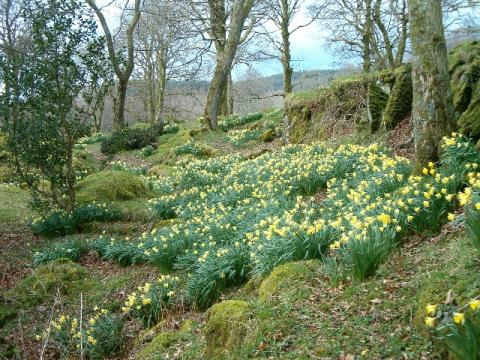
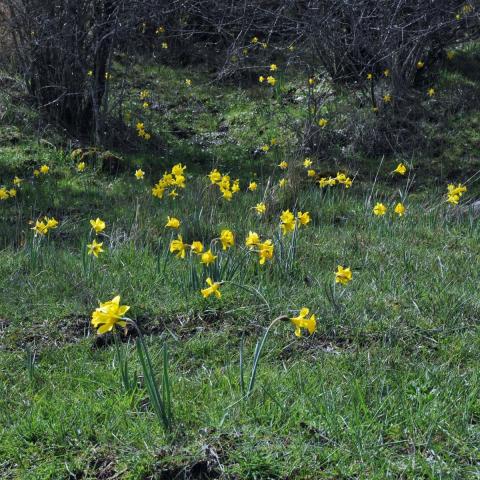 The different daffodil species are native in a variety of habitats from sea level to sub-alpine elevations in lands around the Mediterranean Sea, Greece, Italy, Sardinia, Cyprus, Corsica, Turkey, France, Portugal, and Spain. Their habitat continues around the coast of Lebanon, Israel and Syria, and westward into Egypt, Morroco, and Algeria. Further into Europe, Spain is the center of daffodil species, growing natively in Portugal, up to France and Great Britain, and in Switzerland, Austria and on into eastern Europe. More species can be found growing throughout the Iberian Peninsula, including the Pyrenees Mountains and Moroco, than anywhere else.
The different daffodil species are native in a variety of habitats from sea level to sub-alpine elevations in lands around the Mediterranean Sea, Greece, Italy, Sardinia, Cyprus, Corsica, Turkey, France, Portugal, and Spain. Their habitat continues around the coast of Lebanon, Israel and Syria, and westward into Egypt, Morroco, and Algeria. Further into Europe, Spain is the center of daffodil species, growing natively in Portugal, up to France and Great Britain, and in Switzerland, Austria and on into eastern Europe. More species can be found growing throughout the Iberian Peninsula, including the Pyrenees Mountains and Moroco, than anywhere else.
Accounts exist of early plant enthusiasts from the sixteenth century and after, or perhaps much earlier, just without written records. No doubt many of these trips are similar to plant hunting expeditions still done in the twenty first century. Here are excerpts from an account that appeared in the June, 2003 issue of the Daffodil Journal, by Steve Hampson, "Chasing Wild Daffodils in Spain". Hampson traveled through the mountains of southeastern Spain with three friends to see in their natural habitat "some of the wild cousins of our garden daffodils." Included among his friends was an avid narcissus enthusiasist who had mapped out a 1,500 mile route where they would be sure of encountering many narcissus in the wild. (Wild Daffodils in Spain, photo at left, Carlos Van der Veek.) Early into his trip, Hampson recounts:
"As we looked up the slope on which grew wild lavender and thyme, we began to see spots of bright yellow that were the daffodil flowers {probably N. radinganoram}. The small yellow trumpets sat on six-inch stems and were scattered over an area of about an acre." The next day, after trying a few sites, "We hiked across a grassy slope toward a large rock outcropping, and sure enough, we began seeing clumps of small, golden yellow daffodils growing among the broken rocks. The one-inch flowers on six-inch stems were those of N. cuatrecasasii. As we scrambled up and down the rocks looking at individual clumps, we began to notice variation in shape and size of flowers. " Driving further north, then, encountered N. fernandesii at 3000 feet in elevation, a species of jonquil daffodils. Climbing higher, they entered a dry woodland with pines and cork oaks. At about 3400 feet among grasses and low shrubs they found N. hedreanthus, a Bulbocodium daffodil.
"We retraced our route to Santa Elena. Near the town we found a hillside that rose up from a small stream that was covered with N. triandrus subsp. pallidulus -- thousands of them. . . . About 40 miles northwest of Santa Elena, we made our way up to Castillo de Calatrava, a centuries-old, fortified castle that was built on top of a mountain rising about the plain. Growing in the thin topsoil on the mountainside and between fissures in the rocks was N. cantabricus subsp. monophyllus," a pure white bulbocodium. Not too far on the same ricky ridge they spied N. rupicola, a species named for its preference for rocky areas.
Back in the car they drove to another location along their route. "As we drove into the Sierre Madrona, we crossed a small stream where N. jonquilla var minor was growing along the bank in moist to wet soil. A few plants were actually growing in the water. Most of the 12-inch scapes had from one to four, rounded, rich yellow and sweetly scented flowers. We walked about one-fourth mile downstream and found plants scattered along its length, but never very far from the stream itself. Again, there was considerable variation in flower form and size." And on they explored for almost a week discovering several of "the wild cousins" they had yearned to see. The journal article included numerous photos of the narcissus they encountered. What I find amazing is the variety of the different species living in different environments in a relatively small area of their expedition.
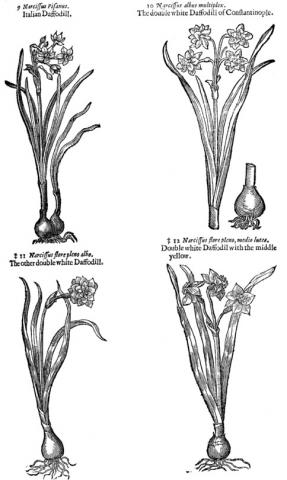 In the 1500’s, the cultivation of species trumpet daffodils appeared in British and central European gardens during the medieval periods, coming from Spanish and Provencal gardens. (The Image of Daffodil in Art and Botanical Illustration.) The hugely influential John Gerald’s Herbal (photo at left) from 1597 has a chapter on daffodils, listing over a dozen different ones, indicating the daffodil was well known and wide spread already.
In the 1500’s, the cultivation of species trumpet daffodils appeared in British and central European gardens during the medieval periods, coming from Spanish and Provencal gardens. (The Image of Daffodil in Art and Botanical Illustration.) The hugely influential John Gerald’s Herbal (photo at left) from 1597 has a chapter on daffodils, listing over a dozen different ones, indicating the daffodil was well known and wide spread already. 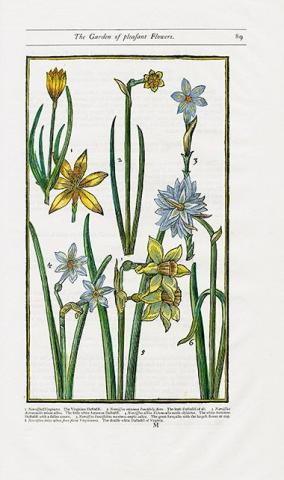
In this letter, from A May-Day Idyl, dating back to 1610, in which Ralph Cunnynghame writes to his cousin, Sir Robert Stapleton in London:
Daffodils became popular in the landscapes of Europe in the early seventeenth century during the Elizabethan period. An early, important plantsman, John Tradescant (1570-1638), traveled widely across Europe searching for plants for his wealthy clients. In 1611, it is known that he brought back from the Iberian peninsula, a large quantity of daffodil bulbs. (Willis, Yellow Fever.) It was John Parkinson (1567 -1650), one of the first English Botanists and apothecary to James I, who introduced the great double yellow Spanish daffodil, (Pseudonarcissus aureus Hispanicus flore pleno or Parkinson’s Daffodil), to England. One of the most eminent gardeners of his day, he is famous for his book ‘Paradisi in Sole Paradisus Terrestris' (Park-in-Sun’s Terrestrial Paradise) written in 1629. (Photo at right of some of Parkinson's daffodils.)
Two to three hundred varieties were available by the eighteenth century. This was well before the time when hybridizing and cultivar creation was understood. The general understanding was that God had created all possible species, and no other could be created by human intervention. With more and more gardeners (really, only the upper class of society who had the time and money to garden) planting the various species in close proximity in garden beds or parterres, it is easy to see how so many different natural crosses could develop over time. Bees flying from one species to another pollinating and cross pollinating. These botanists/naturalists were quick to spot any differences in flowers that would spring up from time to time. And in the wild, as well, where more than one species grew nearby, natural hybrids could be found.
But then, it takes five to six years from a daffodil seed to mature enough to flower, so chance seedlings had to survive several years of weeding in botanists’ gardens to make it to flower stage. It wasn’t until nearly mid-nineteenth century that growers began to realize that some of the daffodil species probably weren’t species, but wild hybrids – a really radical thought. But once they crossed that thought barrier, they soon started to think that they, themselves, could cross breed cultivars.
William Herbert was one such breeder. Shortly before he died in 1843, he wrote a paper on hybridization, which was put to much use by fellow breeders thereafter. Before his death, Herbert had achieved the office of Dean of the Church of England in Manchester. Writing by such an eminent personage in the church helped break down resistance to hybridization.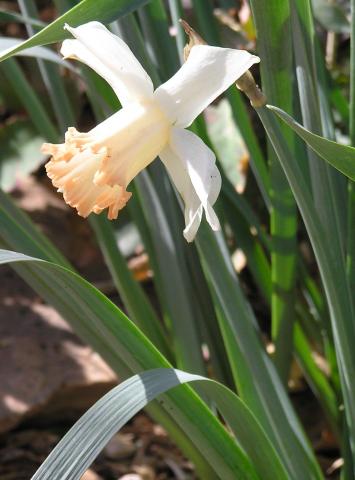
Edward Leeds, also of Manchester, was another early daffodil breeder of the mid-nineteenth century. Leeds “rummaged through Europe” and scoured every catalog for daffodil varieties during his lifetime. In failing health, he tried to enlist interest in his collection, to no avail. Eventually, Peter Barr and a group of interested people bought his collection of 24,000 bulbs.
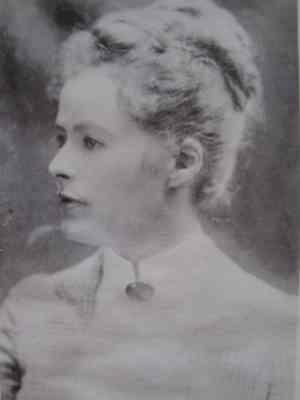 In the early nineteenth century, the Backhouse family participated in daffodil breeding; Edward, his brother William and and his brother’s son, also William Backhouse. The Backhouses worked on color using the Poeticus varieties as well as the yellow trumpet, N. pseudonarcissus, developing a group of hybrids. The second William’s son, Robert O. Backhouse, and his wife Sarah Elizabeth (photo at left), were real stars of both breeding and marketing daffodils. One of Sarah’s most famous daffodils is ‘Mrs. R. O. Backhouse (2W-P see Daffodil Code in the second GardenNotes on Daffodils), the first pink-cup daffodil (photo at right), that Robert named after his beloved wife and partner after she died. I grew ‘Mrs. R. O. Backhouse' for many years in my garden, but lost it due to too much digging and replanting in the bed. If I had known this story years earlier, I would have taken great care not to loose it. Their son, another William, William O. Backhouse, concentrated on red, orange and pink tones of daffodils (Kingsbury, Daffodils). This William Backhouse bred the first Div. 1 red trumpet daffodil, ‘Brer Fox.’ In daffodil colors, calling a daffodil pink or red refers to the corona color, not the entire flower. ‘Brer Fox’ is actually a deep orange-red, but still a breakthrough. It is estimated that roughly 430 varieties of daffodils were raised by the various Backhouses (Kingsbury, Daffodils).
In the early nineteenth century, the Backhouse family participated in daffodil breeding; Edward, his brother William and and his brother’s son, also William Backhouse. The Backhouses worked on color using the Poeticus varieties as well as the yellow trumpet, N. pseudonarcissus, developing a group of hybrids. The second William’s son, Robert O. Backhouse, and his wife Sarah Elizabeth (photo at left), were real stars of both breeding and marketing daffodils. One of Sarah’s most famous daffodils is ‘Mrs. R. O. Backhouse (2W-P see Daffodil Code in the second GardenNotes on Daffodils), the first pink-cup daffodil (photo at right), that Robert named after his beloved wife and partner after she died. I grew ‘Mrs. R. O. Backhouse' for many years in my garden, but lost it due to too much digging and replanting in the bed. If I had known this story years earlier, I would have taken great care not to loose it. Their son, another William, William O. Backhouse, concentrated on red, orange and pink tones of daffodils (Kingsbury, Daffodils). This William Backhouse bred the first Div. 1 red trumpet daffodil, ‘Brer Fox.’ In daffodil colors, calling a daffodil pink or red refers to the corona color, not the entire flower. ‘Brer Fox’ is actually a deep orange-red, but still a breakthrough. It is estimated that roughly 430 varieties of daffodils were raised by the various Backhouses (Kingsbury, Daffodils).
Other breeders, such as Ian Brodie of Scotland, Guy Wilson (‘Passionale’) and Lionel Richardson (‘Rose Royale’) of Ireland and Grant Mitsch of the United States with ‘Accent’ (photo at lower right) continued on with breeding pink and red(-ish) daffodils.
In time, the Backhouse gardens and collections fell into disrepair. Their family’s Backhouse Nursery was put under the bulldozer for a park with little of the original features or plants existing today. After many years, Caroline G. Thomson, direct descendant and 6th generation of the Backhouse horticulturalists, scrambled and enlisted the aid of family members and others to preserve the Backhouse daffodil collection. Bulbs were donated by many daffodil growers to reclaim the collection. Today, the Backhouse Rossie Estate in Scotland includes 89 Backhouse cultivars and has been awarded National Plant Collection status by Plant Heritage in 2016.
 Slowly, in the mid-eighteenth century, the daffodil fell out of favor, as new gardening schemes overtook the landed class. Capability Brown and Humphry Repton ushered in a new garden styles with flowing landscapes that saw many estate gardens ripped up for huge landscape parks. Boxed parterres were torn out; tulip and daffodil bulbs were dug up and discarded from formal gardens and dumped along the hedgerows, waiting to be rediscovered by Peter Barr and others around 1884. Daffodils fared much better than the old English-type tulips (regrettably), as many daffodils were thriving across the land when Barr went searching for them, un-cared for decades later. (Photo at left of daffodils at hedgerows, Great Britain.)
Slowly, in the mid-eighteenth century, the daffodil fell out of favor, as new gardening schemes overtook the landed class. Capability Brown and Humphry Repton ushered in a new garden styles with flowing landscapes that saw many estate gardens ripped up for huge landscape parks. Boxed parterres were torn out; tulip and daffodil bulbs were dug up and discarded from formal gardens and dumped along the hedgerows, waiting to be rediscovered by Peter Barr and others around 1884. Daffodils fared much better than the old English-type tulips (regrettably), as many daffodils were thriving across the land when Barr went searching for them, un-cared for decades later. (Photo at left of daffodils at hedgerows, Great Britain.)
Peter Barr (1826–1909), was in the plant trade in Covent Garden, importing and selling plants and bulbs from The Netherlands, when he read Paradisi in sole paradisus terrestris (1629) by John Parkinson. From it, he learned about the 94 varieties of daffodils known in Britain at that time. Very few of these were available – or even known. He was moved to begin collecting all the known varieties he could find. His efforts in buying daffodil collections of Leeds, Backhouse and others – the accumulated breeding efforts of the past – was of immense help to better understand the history and future breeding of daffodils.
Barr, known as the “Daffodil King,” was responsible for not only popularizing the daffodil in the horticulture industry, but also introduced the concept of “naturalizing”, which should, in most cases, be called perennializing. Barr also created a classification system for future breeders, and truly set the stage for the massive increase in daffodil breeding in the 19th century. In the later part of his career, he traveled across Spain, Portugal and France searching for daffodil species used in new breeding programs. Peter Barr was one of the first recipients of the RHS Victoria Medal for horticultural achievements.
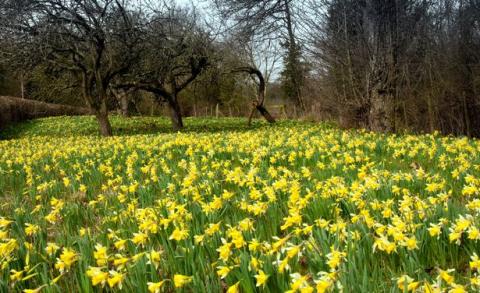 Many others, including George Engleheart, Major Ian Brodie, Ellen Wilmott, Percival. D. Williams (of ‘Carlton’ daffodil fame) and his sons Michael, and Alec Gray, who brought the world ‘Tête-à-Tête’, enabled the daffodil to be the diversified flower it is today. Besides his work on pink daffodils, J. Lionel Richardson and his wife worked on many daffodil cultivars, including the doubles. More recently, important British breeders include Brian and Betty Duncan and Ron Scamp.
Many others, including George Engleheart, Major Ian Brodie, Ellen Wilmott, Percival. D. Williams (of ‘Carlton’ daffodil fame) and his sons Michael, and Alec Gray, who brought the world ‘Tête-à-Tête’, enabled the daffodil to be the diversified flower it is today. Besides his work on pink daffodils, J. Lionel Richardson and his wife worked on many daffodil cultivars, including the doubles. More recently, important British breeders include Brian and Betty Duncan and Ron Scamp.
Today, the daffodil is still of immense importance to Britain, both in breeding, commercial production and eco-tourism. The Golden Triangle (photo at left) celebrates the daffodil, centered in the Cotswolds near the Gloucestershire/Herefordshire border at the village of Kempley, where guided, informative tours take place in March, complete with a Daff’ n’Ride bus service from car park to trail. Tourists can walk along a 10 mile circular trail and experience daffodils in the manner of Wordsworth. Numerous gardens throughout Britain also feature daffodils in the spring.
In the sixteenth century, the first daffodil species were brought into the Netherlands. In 1561, Matthias de Lobel brought N. tazettas from southern France. There is little history of the daffodil compared to the tulips in the Netherlands until the eighteenth century. Some of the Dutch growers and breeders were Simon Adrian de Graaff, known as the “Dutch Daffodil King.” He is known for a number of cultivers, including the first apricot colored corona, named ‘Apricot,’ and ‘February Gold’, a cyclamineus daff, still grown today a hundred years later. Some of the breeders involved with tulips – Ernst Krelage and J. W. Lefeber, raised daffodils in the twentieth century. J. Gerritsen is known for working on split corona daffodils, ‘Cassata’ registered in 1963, appears in the catalogs annually today, as well as ‘Mount Hood’, raised by P. van Deursen, registered in 1937, and ‘Thalia’ by van Waveren in 1916. One of the most famous trumpet daffodils that many people use instead of 'King Alfred' is 'Dutchmaster', bred by Matthew Zandbergen, registered in 1948. Very tall to 26" and strikingly gold, 'Dutchmaster' makes a noble presence in the early spring garden. (Photo at right is 'Ringtone' by van der Veek and 'Golden Echo' in the background, by Brent and Becky Heath.)
With the exception of the Netherlands, the majority of daffodil growing and breeding is done in English speaking countries, exported to them from Great Britain, similar to what occurred in the United States. Australia and New Zealand imported the love of daffodils early on and both have thriving daffodil societies, growers, and breeders.
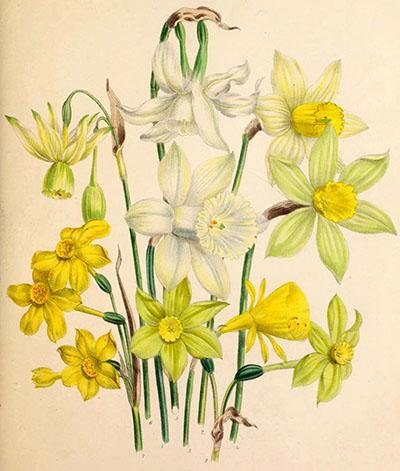 Many early settlers may have brought along bulbs of daffodils to America, however one of the first mentions of daffodils is when America’s first botanist, the Quaker John Bartram, received a shipment of 40 unnamed varieties of daffodils in 1740 in Philadelphia from Peter Collinson in England (Letter from Collinson to Bartram.). Bartram and Collinson carried on a correspondence and exchanged plants between the American Colonies and England for decades. Collinson had previously shipped John Custis, another colonial plant enthusiast, a box of 20 daffodils in the 1730’s. Years later, in 1763, Collinson sent Bartram the double white daffodil 'Albus Plenus Odoratus' (1601 and still available today), with Bartram calling it 'Double Sweet Daffodil', while Collinson knew it as 'Sweet White Narcissus'. According to Bartram, “If I had known the 'White Double Daffodil' had been such a rarity to thee, I could have sent thee large quantities thirty years ago. Our first settlers brought them with them, and they multiply so that thousands are thrown away (October 23, 1763).” (Van Beck, "Daffodils in Early Southern Gardens". )
Many early settlers may have brought along bulbs of daffodils to America, however one of the first mentions of daffodils is when America’s first botanist, the Quaker John Bartram, received a shipment of 40 unnamed varieties of daffodils in 1740 in Philadelphia from Peter Collinson in England (Letter from Collinson to Bartram.). Bartram and Collinson carried on a correspondence and exchanged plants between the American Colonies and England for decades. Collinson had previously shipped John Custis, another colonial plant enthusiast, a box of 20 daffodils in the 1730’s. Years later, in 1763, Collinson sent Bartram the double white daffodil 'Albus Plenus Odoratus' (1601 and still available today), with Bartram calling it 'Double Sweet Daffodil', while Collinson knew it as 'Sweet White Narcissus'. According to Bartram, “If I had known the 'White Double Daffodil' had been such a rarity to thee, I could have sent thee large quantities thirty years ago. Our first settlers brought them with them, and they multiply so that thousands are thrown away (October 23, 1763).” (Van Beck, "Daffodils in Early Southern Gardens". )
Lady Jane Skipworth was notable gardener during the colonial period and had listed having and wanting daffodils in her garden. From her lists of plants, one labeled List of Plants for Mrs. Boyd, she includes “Double, single and poly anthus [multi flowering] Narcissus [probably a tazetta], Daffodil [most likely N. pseudonarcissus], Double Jonquil [probably ‘Flore Pleno’]”. In a list of flower seeds purchased from Minton Collins, nurseryman in Richmond in 1793, are “3 double variegated narcis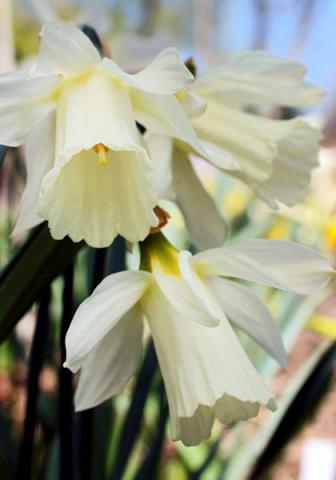 sus [known as Butter and Eggs], and 3 Polianthus narcissus [most likely N. tazetta].” (Leighton, Ann, American Gardens in the Eighteenth Century.) 'Albus Plenus Odoratus', dating back to 1601; N. x odorus ‘Plenus’, 1601; and ‘Butter and Eggs’ daffodil, 1777, and many others can still be bought from Old House Gardens.
sus [known as Butter and Eggs], and 3 Polianthus narcissus [most likely N. tazetta].” (Leighton, Ann, American Gardens in the Eighteenth Century.) 'Albus Plenus Odoratus', dating back to 1601; N. x odorus ‘Plenus’, 1601; and ‘Butter and Eggs’ daffodil, 1777, and many others can still be bought from Old House Gardens.
“The well-known Philadelphia seeds-man Bernard M'Mahon offered for sale fourteen daffodils by name in 1806. Five of these are still regularly found across the South. These were (are) N. pseudonarcissus (sometimes called "Lent lily" or "Early Virginia"), N. biflorus (now named N. x medioluteus, common name "Twin Sisters"), N. x odorus (common name 'Campernelle' jonquil), N. jonquilla and a white trumpet N. moschatus (called 'Silver Bells,' rare but present, photo at right from Old House Gardens). M'Mahon corresponded regularly with Thomas Jefferson, and it was from him whom Jefferson obtained his plants for Shadwell and later Monticello.” (Van Beck, "Daffodils in Early Southern Gardens.")
As a botanist, plant collector and exporter, John Bartram traveled throughout the colonies. On a trip in 1765 to South Carolina, Bartram visited the celebrated garden of Henry Laurens at his plantation in Charleston. It was found in Laurens’ papers, a 1763 plant order from Sarah Nicholson and Company in England that included a "Pseudo Narcissus or Yellow (or white) Daffodil"; N. pseudonarcissus considered to be a common plant for such a distinguished gardener to order. John Watson, Lauren’s gardener, set up his own business, importing and selling Dutch bulbs, including the very fashionable double jonquils. (Van Beck, "South Carolina and the History of Daffodils.")
Thomas Jefferson and John Adams were in England together in 1786 negotiating for the new United States. During an impasse in mid-March, they left London for a tour of the countryside and gardens, undoubtedly seeing many fields of daffodils gracing the countryside, and more rare and expensive specimens in the gardens they viewed. At Monticello, Jefferson noted in his diaries that "Narcissus" bloomed on April 6, 1766, and noted again on March 17, 1782 (Monticello, Daffodils and Jonquils.)
When John and Abigail Adams returned to their home in Quincy, it was in time to see the very last of their daffodils (most likely N. poeticus). Either they had sent bulbs back home while they were still in England, or, like other colonists, had been growing them for years. It was common practice for Jefferson, and I would think Adams, to steadily send seeds and bulbs back to their farm managers, and for their friends. (Wulf, Founding Gardeners.)
There are several daffodils that date back to the time of George Washington that are currently planted at Mount Vernon. Most likely these are some of the same species and varieties of daffodils Washington, himself, had in his garden.
As time passed in the early years of the United States, and as commerce between England and the U. S. normalized, a brisk trade in bulbs ensued. William Prince, a nurseryman in Flushing New York, offered over ninety daffodils in his catalog of 1822, including “65 tazettas, fourteen singles, six doubles and four jonquils (single and double).” (Van Beck, "Daffodils in Early Southern Gardens"). ('Bell Song', a jonquillia and 'Thalia', a tazetta daffodil at right.)
The “Daffodil King” Peter Barr (mentioned above in European Daffodil History) was responsible for starting the The New York Botanical Garden’s daffodil collection in 1898 with a gift of about 52 varieties. (Lyman, Claire; Uncovering Historic Daffodils at the New York Botanical Gardens, November 30, 2020.) Today, the New York Botanical Gardens displays hundreds of thousands of daffodils. Click here for a one minute video of daffodils at the NYBG.)
The United States features a number of successful daffodil breeders. Grant Mitsch was probably the greatest of our breeders. In addition to ‘Accent’, he is known for ‘Jetfire’, ‘Stratosphere’, ‘Pipit’ and some often seen in catalogs today. His daughter Elise Havens, along with her husband Richard have continued in Mitsch’s footsteps, registering over three hundred cultivars. Brent and Beck Heath's focus in Virginia is in breeding daffodils for American Gardens. Robert Spotts has a breeding program in California, as does Harold Koopowitz, among others. (Photo at left of Golden Echo, a Heath daffodil and Wister award winner.)
Brent and Becky's Bulbs began in the early 1900's in Virginia with Brent's grandfather, Charles Heath. Daffodils were growing all around the area -- presumably from Colonial times. Charles Heath established a bulb business, selling not just the locally grown bulbs and flowers, but also imported newer and better cultivars. Because of his success, a Dutch firm, Van Wavern, established a bulb operation during the period between the First and Second World Wars, just before the United States instituted a bulb embargo. Charles' son, George, managed the operation during WWII. Brent grew up in the daffodil industry, learning every aspect of it. Brent's mother started a large display garden, which over time, attracted over 20,000 visitors a year. Eventually, Brent purchased the business from his mother and began The Daffodil Mart. He asked and received help and additional training from various breeders, including Zanderbergen from the Netherlands, and Grant Mitsch from California.
In the 1970's Brent Heath changed his business model, instead of growing many of the cultivars, imported more for sales and delved into daffodil breeding. Brent and Becky's Bulbs is now located in Glouscester, Virginia, with large display and trial gardens. Their focus is on developing more fragrance, with more interest in great garden plants with good show qualities. (Heath, Daffodils, and Kingsbury, Daffodils.)
Many botanical gardens across our country feature impressive daffodil displays. The Missouri Botanical Gardens in St. Louis displays nearly 700 cultivars among their gardens, including the Shaw Nature Preserve. MOBOT’s daffodil collection is overseen by the Greater Saint Louis Daffodil Society. In 2007, the American Daffodil Society named the MOBOT collection the first ADS Daffodil Display Garden.
The largest daffodil display is in the south, at Ball Grounds, Georgia, one hour north of Atlanta, at Gibbs Gardens, featuring over 20 million daffodils in 200 different cultivars over 50 acres. The Gibbs Gardens Daffodil Festival runs from early March through mid-April, and is also an ADS Daffodil Display Garden. Truly, this must be a sight magnifique!
The history of the daffodil and its development, as one might expect, is long and involved, and quite interesting. To learn of the patient work over decades to unlock and develop traits that weren’t at all visible in the wild species, especially the pinks, the doubles and split corona daffodils, and expanding the range of plants through the growing season, is to gain a deep appreciation for the array of cultivars available to us today with just a click. They are unlike the tulip, where through centuries of hybridization, breeders have turned the perennial tulip bulb, in many cases, into an annual. Though one of the most splendid flowers of the spring, tulips are bred to reproduce and come back year to year under very narrow conditions and environments that most gardeners do not enjoy.
The daffodil, hybridized over centuries, gives us a magnificient and diverse array of flowers where the bulbs faithfully return for many, many years throughout the temperate world. None of this really explains the "why" of daffodil's ability to cause obsession. It's allure, to me, is still hard to describe. I think, perhaps, one must first know and truly experience the daffodil -- as in most substances that lead to obsession -- to be under its spell.
Read the second article in the Daffodil Series, Daffodil Organization, that explains the 13 divisions and code system that govern the thousands of registered cultivars.
And read the third article in the Daffodil Series, Growing Daffodils in the Texas Panhandle, tips and ideas to increase your success in growing daffodils.
American Daffodil Society Informative website about all things daffodils.
Barr, Peter. Ye Narcissus or Daffodil Flowre, London, 1884. From DaffLibrary.
Brady, Rose. The ‘King Alfred’ Story, The Daffodil Society (Great Britain), 1999.
The Image of Daffodil in Art and Botanical Illustration: Clues to the History of Domestication and Selection of Narcissus subgenus Ajax (Amaryllidaceae)
Kingsbury, Noel. Daffodil the Remarkable Story of the World Popular Flower, Timber Press, 2013.
Hampson, Steve. "Chasing Wild Daffodils in Spain", Daffodil Journal, June, 2003.
Heath, Brent and Becky. Daffodils for American Gardens, Bright Sky Press, 2001.
Leighton, Ann. American Gardens in the Eighteenth Century, University of Massachusetts Press, 1976.
Lyman, Claire. Uncovering Historic Daffodils at the New York Botanical Gardens, November 30, 2020
Van Beck, Sara. "Daffodils in Early Southern Gardens", Magnolia Eden, Southern Edition, March 27, 2009
Van Beck, Sara. "South Carolina and the History of Daffodils", Magnolia Eden, Southern Edition, March 27, 2012.
Willis, David. Yellow Fever, A Prospect of the History and Culture of Daffodils, Privately Published by the author, 2012. An eBook in the DaffLibrary.
Wulf, Andrea. Founding Gardeners, Vintage Books, 2011.